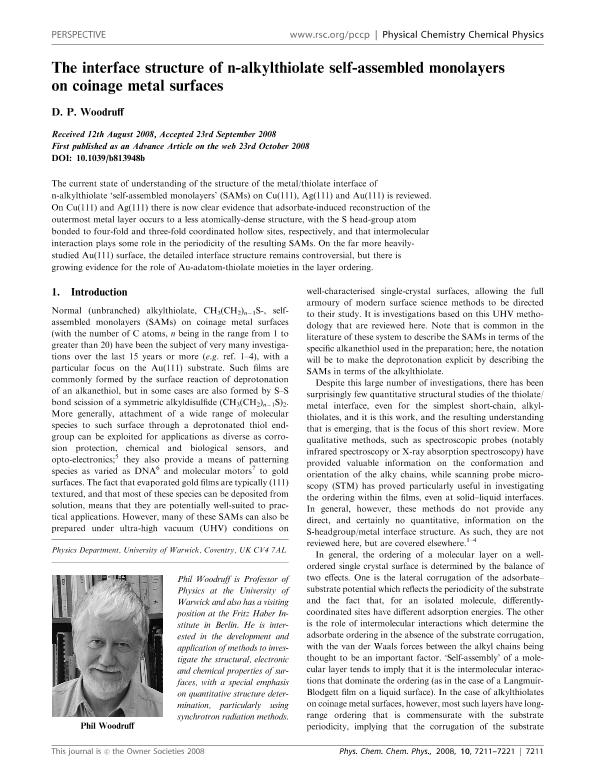Mostrar el registro sencillo del ítem
dc.contributor.author
Juarez, Maria Fernanda

dc.contributor.author
Soria, Federico Ariel

dc.contributor.author
Patrito, Eduardo Martin

dc.contributor.author
Paredes Olivera, Patricia

dc.date.available
2018-10-11T20:49:20Z
dc.date.issued
2011-12
dc.identifier.citation
Juarez, Maria Fernanda; Soria, Federico Ariel; Patrito, Eduardo Martin; Paredes Olivera, Patricia; The role of the organic layer functionalization in the formation of silicon/organic layer/metal junctions with coinage metals; Royal Society of Chemistry; Physical Chemistry Chemical Physics; 13; 48; 12-2011; 21411-21422
dc.identifier.issn
1463-9076
dc.identifier.uri
http://hdl.handle.net/11336/62257
dc.description.abstract
The design of silicon/alkyl layer/metal junctions for the formation of optimal top metal contacts requires knowledge of the mechanistic and energetic aspects of the interactions of metal atoms with the modified surface. This involves (a) the interaction of the metal with the terminal groups of the organic layer, (b) the diffusion of metal atoms through the organic layer and (c) the reactions of metal atoms with the silicon surface atoms. The diffusion through the monolayer and the metal catalyzed breakage of Si-C bonds must be avoided to obtain high quality junctions. In this work, we performed a comprehensive density functional theory investigation to identify the reaction pathways of all these processes. In the absence of a reactive terminal group, gold atoms may penetrate through a compact alkyl monolayer on Si(111) with no energy barrier. However, the presence of thiol terminal groups introduces a high energy barrier which blocks the diffusion of metals into the monolayer. The diffusion barriers increase in the order Ag < Au < Cu and correlate with the stability of metal-thiolate complexes whereas the barriers for the formation of metal silicides increase in the order Cu < Au < Ag in correlation with the increasing metallic radii. The reactivity of gold clusters with functionalized Si(111) surfaces was also investigated. Metal silicide formation can only be avoided by a compact monolayer terminated by a reactive functional group. The mechanistic and energetic picture obtained in this work contributes to understanding of the factors that influence the quality of top metal contacts during the formation of silicon/organic layer/metal junctions. © 2011 the Owner Societies.
dc.format
application/pdf
dc.language.iso
eng
dc.publisher
Royal Society of Chemistry

dc.rights
info:eu-repo/semantics/openAccess
dc.rights.uri
https://creativecommons.org/licenses/by-nc-sa/2.5/ar/
dc.subject
Alcanotioles
dc.subject
Si(111)
dc.subject
Junturas Metalicas
dc.subject
Difusion
dc.subject.classification
Otras Ciencias Químicas

dc.subject.classification
Ciencias Químicas

dc.subject.classification
CIENCIAS NATURALES Y EXACTAS

dc.title
The role of the organic layer functionalization in the formation of silicon/organic layer/metal junctions with coinage metals
dc.type
info:eu-repo/semantics/article
dc.type
info:ar-repo/semantics/artículo
dc.type
info:eu-repo/semantics/publishedVersion
dc.date.updated
2018-10-01T15:23:44Z
dc.journal.volume
13
dc.journal.number
48
dc.journal.pagination
21411-21422
dc.journal.pais
Reino Unido

dc.journal.ciudad
Cambridge
dc.description.fil
Fil: Juarez, Maria Fernanda. Consejo Nacional de Investigaciones Científicas y Técnicas. Centro Científico Tecnológico Conicet - Córdoba. Instituto de Investigaciones en Físico-química de Córdoba. Universidad Nacional de Córdoba. Facultad de Ciencias Químicas. Instituto de Investigaciones en Físico-química de Córdoba; Argentina
dc.description.fil
Fil: Soria, Federico Ariel. Consejo Nacional de Investigaciones Científicas y Técnicas. Centro Científico Tecnológico Conicet - Córdoba. Instituto de Investigaciones en Físico-química de Córdoba. Universidad Nacional de Córdoba. Facultad de Ciencias Químicas. Instituto de Investigaciones en Físico-química de Córdoba; Argentina
dc.description.fil
Fil: Patrito, Eduardo Martin. Consejo Nacional de Investigaciones Científicas y Técnicas. Centro Científico Tecnológico Conicet - Córdoba. Instituto de Investigaciones en Físico-química de Córdoba. Universidad Nacional de Córdoba. Facultad de Ciencias Químicas. Instituto de Investigaciones en Físico-química de Córdoba; Argentina
dc.description.fil
Fil: Paredes Olivera, Patricia. Consejo Nacional de Investigaciones Científicas y Técnicas. Centro Científico Tecnológico Conicet - Córdoba. Instituto de Investigaciones en Físico-química de Córdoba. Universidad Nacional de Córdoba. Facultad de Ciencias Químicas. Instituto de Investigaciones en Físico-química de Córdoba; Argentina
dc.journal.title
Physical Chemistry Chemical Physics

dc.relation.alternativeid
info:eu-repo/semantics/altIdentifier/doi/https://dx.doi.org/10.1039/c1cp22360g
dc.relation.alternativeid
info:eu-repo/semantics/altIdentifier/url/https://pubs.rsc.org/en/Content/ArticleLanding/2011/CP/c1cp22360g
Archivos asociados
